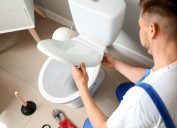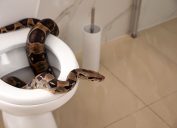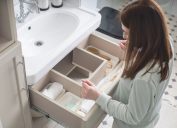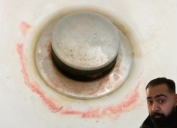How to Unclog a Toilet (Without a Plunger)
An emergency trip to the hardware store isn't necessary!

A clogged toilet is pretty low on the list of home emergencies—as long as you have a plunger handy. Without one, this annoying occurrence turns into a full-on disaster that renders your restroom useless until you make a trip to the store. Fortunately, there are ways to fix the issue without the tool. Read on to learn plumbers' best tips for how to unclog a toilet without a plunger. You'll get things cleared up quickly and easily, so you can switch your focus to your regularly scheduled chores.
RELATED: The 5 Worst Things You're Doing to Your Toilet, According to Plumbers.
Safety Tips for Fixing a Toilet Clogs
There are a few safety considerations to keep in mind when unclogging a toilet. First, you'll want to wear a pair of rubber gloves to protect your hands from any yucky germs they might encounter. You should also ventilate the space by opening the door or, better yet, a window so you're not breathing any noxious air. Finally, grab some towels and put them on the floor around the toilet in case the overflow gets worse before it gets better.
While working on your clog, you should try to stick to enzyme cleaners over harsher chemicals. "While effective at unclogging, chemical cleaners are so powerful that they can actually damage plumbing in your home in the long run," says Joseph Wade, vice president of operations at Benjamin Franklin Plumbing. "They are also toxic—meaning they're just as harmful to your skin and the overall environment as they are to pipes."
Enzyme products, on the flip side, break down biodegradable substances naturally and don't contain any toxins.
RELATED: Why You Shouldn't Be Cleaning Your Bathroom With Bleach, According to Experts.
How to Unclog a Toilet Fast
1. Unclog Your Toilet With Baking Soda and Vinegar

Materials needed: Baking soda, hot water, vinegar.
One of the most effective ways to clear a clogged toilet is with baking soda and vinegar. "In the industry, we refer to this as the Model Volcano Method," says Wade. "This method is less expensive (and not as harsh) on your plumbing than chemicals—and you probably have the key ingredients in your pantry right now."
First, bring a large pot of water to a boil and let it cool for five minutes. Then, add one cup of baking soda to your toilet, followed by two cups of vinegar.
"Pour the water in, being sure to not overflow the bowl, and allow the mixture to work for several hours," says Wade. "Assuming the clog isn't too tough, you should have a fully working toilet after that!"
2. Fix a Clogged Toilet With Hot Water
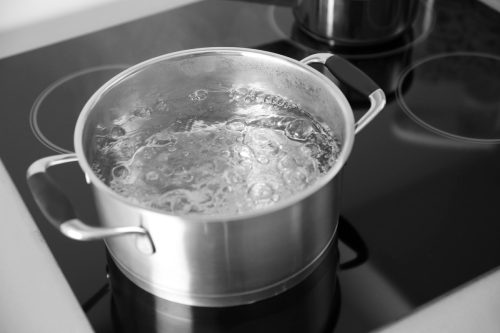
Materials needed: Hot water.
Even if you don't have any other supplies on hand, you hopefully own a large pot and a running tap. To unclog your toilet using those supplies, boil water and let it cool a little, as "boiling water can damage the porcelain of the toilet bowl," says Mark Snell, president of Polestar Plumbing, Heating & Air Conditioning.
Pour the water into the toilet bowl from waist height to ensure it makes as much impact as possible when it hits the toilet. "Wait a few minutes to see if the water level goes down, indicating that the clog is clearing," says Snell. "Note that this method works best for organic clogs and might not be effective for solid objects."
Unfortunately, you may need to remove some of the toilet water with a cup to be able to do it.
3. Unclog Your Toilet With Dish Soap

Materials needed: Hot water, dish soap.
You can also amp up your hot water solution with dish soap. Follow the same steps as you'd take to clear the toilet drain with the water, but add one cup of dish soap for every two liters of water. Drop it into the bowl from waist height, then follow the solution with two more liters of water to loosen the clog.
"This toilet unclogging method works only if the clog is shallow and caused by grease and grime build-up and will be ineffective if the blockage is caused by a bigger object, such as a toy, shampoo cap, or another large object," says Toni Yordanov, plumber and coordinator at Fantastic Plumbers.
4. Fix a Clogged Toilet With an Enzyme Waste Remover

Materials needed: Enzyme waste remover, hot water.
If you choose to use an enzyme waste remover on your clog, you'll want to follow the directions on the product—and note that the process could take a while. "Enzyme waste removers are less harmful to pipes than chemical drain cleaners; however, they do take more time to get the job done," says Wade.
"Once you've poured the product into the bowl, close the lid, and wait overnight, typically eight to 12 hours, for the clog to break down," he explains. "You should be able to flush just fine in the morning."
5. Unclog Your Toilet With a Wire Hanger Drain Snake

Materials needed: Wire hanger.
A wire coat hanger could be used to unclog a drain in place of a drain snake. First, unwind the hanger and straighten it as much as possible, but leave the hook intact.
"This hook will be useful for dislodging and pulling out gunk from the drain—though if the end of the wire is sharp after straightening, use pliers to create a small loop so it doesn't scratch your pipes," says Snell.
Next, insert the hook into the drain. "You need to reach into the drain and either pull out the clog or push it down to clear the passage," says Snell. "If the clog is caused by hair or other fibrous materials, the hook can often latch onto it, allowing you to pull it out. However, be ready that you might have to wiggle or twist the hanger a bit to get a good grip on the clog."
You might not clear the entire clog at once, but you can improve the situation little by little to get things flowing.
6. Plunge Your Toilet With a 2-Liter Bottle
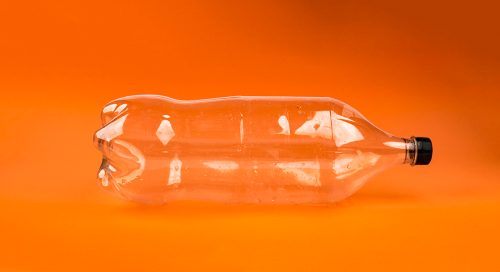
Materials needed: 2-liter plastic bottle, scissors.
Look no further than your recycling bin for a toilet plunger alternative. "After you get a 2-liter bottle, make sure it's empty and clean, then cut off the bottom of the bottle, creating a funnel-like shape," says Yordanov. Place the cut end of the bottle into the drain opening so it creates a nice seal.
"With the bottle in place like that, squeeze it to compress the air inside and create pressure, which will help loosen the clog—if you don't see any results from the first try, repeat the squeezing action a few more times and then flush the toilet to check if the clog is gone," says Yardanov.
Wearing rubber gloves is definitely the way to go here since you'll need to finagle the bottle into the drain.
7. Unblock Your Toilet With the Toilet Brush
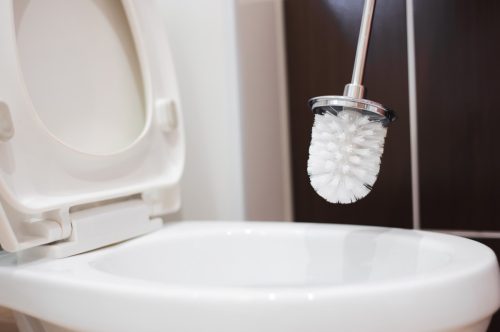
Materials needed: Toilet brush.
A toilet brush isn't useless against a clog. Plus, this method is super easy: "Thrust the brush into the bowl like you would with a plunger and repeat until the clog is loose and ready to be flushed," says Wade. It could be enough to dislodge the issue.
8. Unclog a Toilet Using a Squirt Gun

Materials needed: Squirt gun, water.
This method is simple and uses a similar technique as the hot water method. To do it, fill up a squirt gun with warm water and shoot it at the drain to dislodge the clog. You may need to try a few times to make progress.
RELATED: 7 Toilet Paper Mistakes You're Making.
How Can I Prevent My Toilet From Getting Clogged Again?
To prevent future clogs, one of the best things you can do is only ever flush human waste and toilet paper—and even then, use caution.
"Some types of toilet paper are thicker and more luxurious, often marketed as ultra-soft or ultra-strong, and may not break down as quickly as standard toilet paper and can lead to clogs," says Snell.
You'll also want to avoid wipes, which Snell calls one of the primary culprits of clogs. "Even those labeled as flushable don't break down like toilet paper and cause blockages," he says.
"Similarly, feminine hygiene products, such as tampons and pads, should never be flushed—they expand when in contact with water, which spells disaster for plumbing," Snell adds. Paper towels and tissues can also cause problems because they stay intact when wet, unlike toilet paper which dissolves.
Other non-waste items, including floss, cotton balls, hair, cooking grease, medication, oil, food, and cat litter should also stay away from the toilet to ensure future blockages are few and far between.
Conclusion
Ultimately, there are numerous ways to unclog a toilet without a plunger—and you don't need many supplies to implement them. However, the best fix is prevention. Use your toilet properly to minimize clogs. For more home improvement advice, visit Best Life again soon.
For more home advice delivered straight to your inbox, sign up for our daily newsletter.


